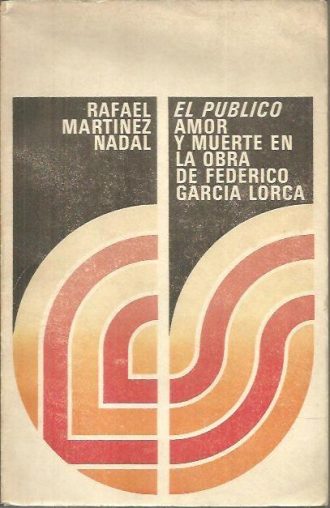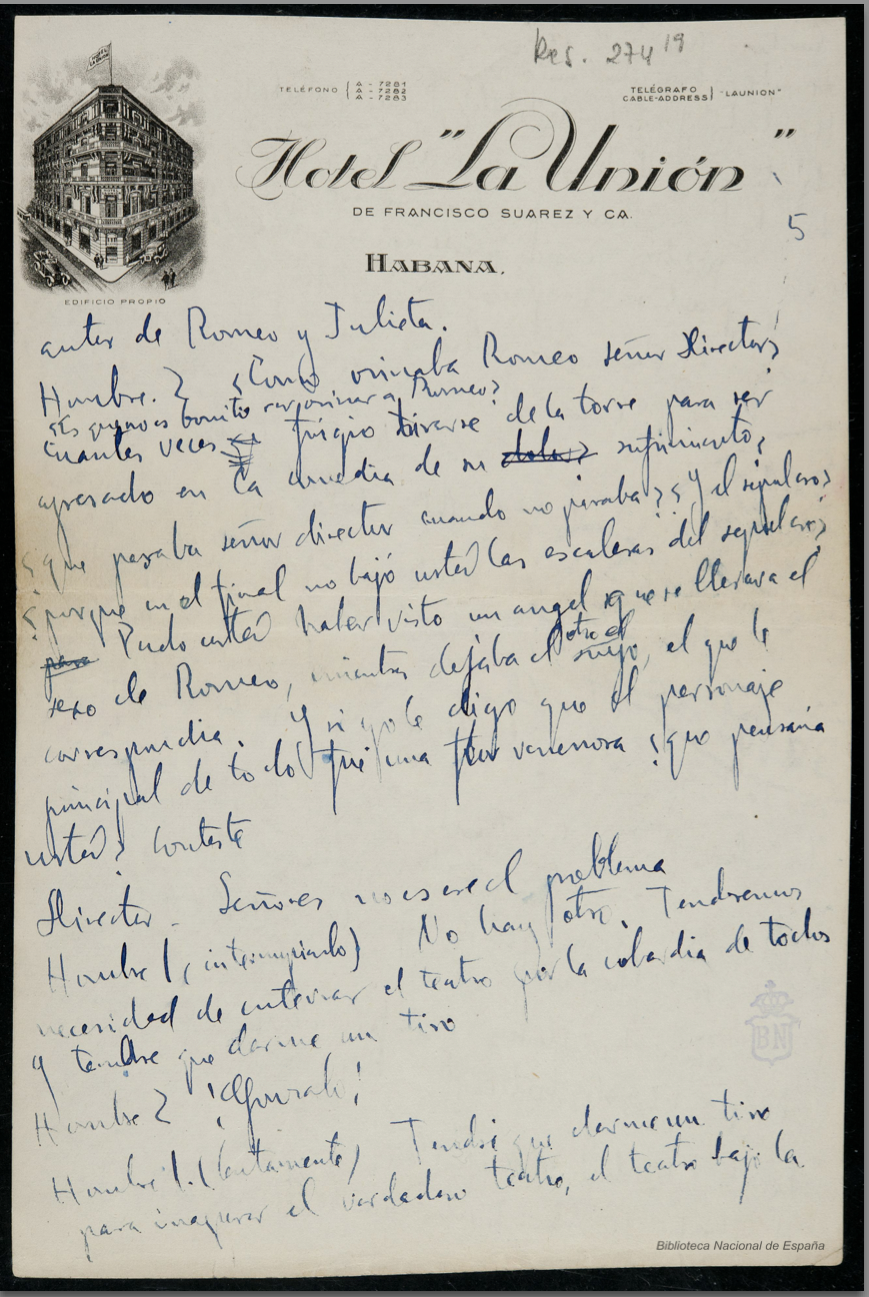
El público (The Public, also known as The Audience). Through a great variety of voices, the author is going to put on stage the universal love, the one that must be lived in freedom: the homosexual or the heterosexual, with characters with or without masks, with or without proper names. “All theater comes out of confined humidities”. Everything that the play’s audience is going to reject: freedom. And theater and desire: “We must destroy the theater or live in the theater!” he exclaims in this play.
It was not premiered during the author’s lifetime. For García Lorca it was an unrepresentable work belonging to what he called the “impossible theater” “Although in these impossible comedies lies my true purpose,” Lorca said in an interview in 1936. The first professional performance was staged in Poland in 1984, although there is evidence of at least two previous versions produced by amateur theater groups, one at the University of Murcia, directed by Antonio Morales (1977), and another at the University of Puerto Rico directed by Victoria Espinosa (1978). The first adaptation in Spain took place at the María Guerrero Theater in 1986. The play is divided into six scenes, plus The Silly Shepherd’s Speech, between the fifth and sixth scenes, although even today the fourth is still unknown.
On June 30, 1930, Federico Garcia Lorca arrives in Cadiz from Havana. He had finished his trip to America. On July 1, he is already in the Huerta de San Vicente (San Vicente Farmhouse), where he will spend the whole summer except for a brief stay in Malaga. From America he brought with him a first incomplete version of El público (The Public) (written between New York and Havana). He reworks the text several times. He finishes it in Granada on August 22 as recorded in the manuscript. “I have written a drama -he wrote from the San Vicente Farmhouse to his friend Rafael Martínez Nadal, I would give anything to read it to you in the company of Miguel… I think it is my best poem”.
The manuscript of El público (The Public) was given to Martínez Nadal aboard the train from Madrid that Federico Granada was to take for the last time. And it is mysteriously related to the appearance in one of the wagons of a character (“a deputy for Granada”) that Lorca vehemently shunned and who for years was identified as Ramón Ruiz Alonso, the CEDA militant who organized his arrest a month later in the Rosales’ Family house.
At the beginning of July 1936, Federico García Lorca was in Madrid. Despite the advice of his friends in view of the difficult political situation in Spain, Lorca decides to return to Granada. As every July 18, the García Lorca family celebrates in the Huerta de San Vicente (San Vicente Farmhouse) the feast of St. Federico. And Lorca hesitates, but decides to return to the family home.
On July 16, accompanied by Martínez Nadal, they arrived at the train station: “Settled in the sleeping car, Federico unpacked the books he had bought and autographed them right there; the last ones he was going to sign in Madrid and, possibly, the last ones he signed in his life. They were intended for the Norwegian Hispanist Magnus Grönwold, the stage director Jacob Nielsen and Alfonso Fiscowich. I did as he asked and put them in the mail, but Fiscowich’s was to be returned to me a few days later (…) Someone slipped down the aisle of the sleeping car. Federico, quickly turning his back, waved his two fists in the air giving them the finger: “Lagarto, lagarto (lizard, lizard)! [superstitious exclamation to ward off bad luck]”. I asked him who he was: “A deputy for Granada. A ‘jinx` and a bad person.” Clearly nervous and upset, Federico stood up. Look, Rafael, go and don’t stay on the platform. I’m going to pull the curtains and get into bed so that this creep won’t see me or talk to me”. We gave each other a quick hug and for the first time I left Federico on a train without waiting for it to depart, without laughing or joking until the last minute. When I got home I opened the package Federico had given me. Among personal papers, there was what seemed to be the first draft of five scenes of the drama, unpublished until 1976, El público (The Public). The tasks of destroying everything could not apply to this manuscript.”(R. Martínez Nadal and M. Laffranque, Federico García Lorca. El público y Comedia sin título. (Federico García Lorca. The Public and Untitled Comedy). Two posthumous works, Biblioeteca Breve, Seix Barral Publishing House, 1978).

Martínez Nadal’s statements on the day of Federico’s farewell in Madrid, in which he suggested the presence on the train of the former deputy of the CEDA Ramón Ruiz Alonso, do not hold water. On July 10, when Ruiz Alonso was traveling in a private vehicle from Madrid to Granada to participate with other soldiers in the military uprising, he had a serious accident, which did not cause him major injuries, but it did keep him in the town of Madridejos. The car collided with a truck that crossed his path. Shocked, he was cared for in a house in the town until members of Acción Popular political party went to the La Mancha town to pick him up.
On July 12, 1936, an article published in the Noticiario Granadino reported the accident. Because of this, the `jinx’ to which Martínez Nadal alludes could not have been the coup leader and later organizer of the arrest of Federico García Lorca.
On the other hand, Lorca took the train that was to take him for the last time to Granada on July 13 and not as Martínez Nadal mistakenly notes on the 16th. Before leaving on the all-night journey, the poet visited his literary teacher and friend Antonio Rodríguez Espinosa, and said goodbye to his sister Isabel at the Girls’ Residence. On July 14, the El Defensor newspaper reported Federico’s arrival in Granada in a brief note: “The Granada poet Federico García Lorca has been in his home town since yesterday. The illustrious author of Bodas de sangre (Blood Wedding) intends to spend a short time with his relatives.” (Lorca. The last trip. Gabriel Pozo).
The manuscript consists of four first paintings, the Solo del pastor bobo (The Silly Shepherd’s Speech) and a fifth painting. Lorca noted that the main characters were horses and that it was divided into “six acts and a murder”. The manuscript is typewritten, with abundant autograph corrections. There was another, given to the Loynaz family, which was apparently destroyed, as Miguel García-Posada points out, by Carlos María Loynaz. The study is, therefore, of the incomplete manuscript by Martínez Nadal, first published in 1976.
Lorca gave several readings of El público (The Public). At the end of 1930 or 1931, the first one took place at the home of Carlos Morla Lynch, according to Martínez Nadal’s testimony.
Our theater. Chapter 3: The Lorca’s ‘Impossible’ Theatre Staged
Trailer of El público
The public, theater beneath the sand. Article by Marcos Ordóñez en El País.
First adaptation of The public in the María Guerrero Theater in 1986.
Interview with Rafael Martínez Nadal. A fondo. July 16, 1978 – Blanco y Negro. 58 minutes (summary)
Handwritten pages of El Público in the Spanish National Library.